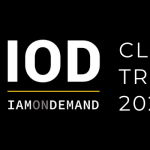According to IOD Expert Jorge Galvis: “Golang Will Be Big.”
“The programming language Golang will be the preferred language for deploying backend APIs on cloud services–at least it will be on the Google Cloud Platform (GCP). This means that Golang will appear as one of the top 10 languages in both Stack Overflow and Github reports next year.
Golang is a language that supports static types and concurrency by design, aspects that many developers complain about when it comes to other languages on the cloud. It is already getting a versatile standard library, and many big companies like Salesforce are considering the language very seriously. I see Golang as the intersection between C’s performance and Python’s elegance–an intersection that seems to be attracting more and more developers (including myself).
The reason I said it will rock on GCP “at least” is because GCP offers great runtime support for Go in compute solutions like Google App Engine and Google Cloud Functions. Also, initiatives like Go Cloud clearly demonstrate Google’s intentions with the language: “We aim to make Go the language of choice for developers building portable cloud applications.”
You may have already used a product written in Golang without being aware of it. Kubernetes? Docker? Terraform? Youtube? All of them are products that use Golang to some extent.”
According to IOD Expert Artem Arkhipov: “Better Serverless Debugging & Bloom of AI/ML…”
“I expect that 2020 will be the year of real breakthroughs in the area of remote, real-time debugging of serverless applications. At the beginning of the serverless era a few years ago, there was a real lack of observability tools for such applications. Services like Epsagon, Thundra, Dashbird and others appeared in this niche, providing various features for comfortable troubleshooting and monitoring applications built with AWS Lambda. A bit later, these services implemented local and distributed tracing functionality to one degree or another.
But one of the big wishes of the community is the ability to effectively debug functions running in a real AWS Lambda environment–remotely from a local machine. Such a feature has already been announced by Thundra, and there are probably some other, not so well-known services trying to provide the same. But all current solutions are still a bit raw to be used overall.
Are you interested in joining IOD’s growing global network of freelance tech experts and writers? Contact us and start to see for yourself how freelancing may be the preferred lifestyle choice for you this year.
I believe that by the end of 2020, we will finally have reliable instruments making the maintenance of serverless apps and the debugging process as easy and comfortable as possible.
There are more things that will probably become widespread in 2020, including AI as a Service (AIaaS), or ML as a Service (MLaaS), and other AI tools. Utilizing artificial intelligence and machine learning has become very popular in almost all areas. Despite the fact that implementing such things is quite a lot easier than before, it still requires special skills and knowledge from developers. Of course, all major cloud providers, such as AWS, Google, IBM, and Azure, already have well-documented, ready-to-use ML services. However, I think that new, alternative services or tools will appear in 2020, making the entry threshold into this area even lower.”
According to IOD Expert Milos Didoc: “Forget ML/AI, Lots of Kubernetes, Return of Windows, VMware & Serverless…”
“Last year, we were bombed by the ML/AI combo all around the globe. But what do we really use nowadays that’s truly and completely powered by ML and AI? Yes, you’re right, only voice assistants and some automotive features on modern cars (which most of us cannot afford); that’s it. And I don’t expect the situation to change in the 366 days (leap year!) of 2020. We’re still years behind a true ML/AI adoption in our everyday life, hell, even in our everyday life, as IT engineers.
Rise of Serverless Services
Here, I’m not just thinking of the adoption of serverless computing services like AWS Lambda or Google Cloud Functions, but more of the “complete” serverless services you consume in the cloud as SaaS. AWS has just introduced support for Kubernetes in Fargate, and I expect many other managed services across all three major clouds–Amazon, Microsoft, and Google–will follow this practice. It’s already possible to have a complete stack of load balancer, Kubernetes cluster, globally managed database engine (with database caching), and object storage, where you don’t need to lift a finger other than to consume all of these with API calls.
I expect this trend to be completely mature by the end of 2020. We will have no idea where our Kubernetes pods and services are running, but we will be sure they will be managed far better than we can by ourselves.
VMware Will Rise (yet again)
Ten to 15 years ago, VMware was what Amazon is today: the undisputed leader in its niche. Everyone wanted to jump into the newly found world of virtualization. Virtualizing underutilized physical servers and getting new resources and increased capacity is a similar approach to what Amazon did when they lured us into the cloud.
VMware lost its way, but I expect them to be on the rise again. Why, specifically? Well, they went and invested in many interesting projects, such as Heptio, Pivotal, CloudHealth, and Bitnami, just to name a few. And all of these will be integrated into their next superstar–Tanzu. Tanzu should be the hypervisor of the future, which you can run both in the cloud and on-premises environments. You should also be able to mix containers of all sorts (not just Docker), VMs, virtual appliances, and many more in one closed and tightly integrated environment.
As I said above, managing Kubernetes in your own datacenter can be really hard. And when you need to manage legacy VMs on top of that, you will have a tough time without a proper hypervisor and monitoring and maintenance tools. Tanzu is cloud-native and open-source, so you won’t be bound by VMware licensing that much, unless you decide to be, of course.
Windows Will Make a Comeback
Yes, I really wrote this one as a prediction. Microsoft is doing a hell of a job with Linux compatibility, with WSL and the newly released Terminal app, and we’ll soon see even further upgrades and improvements with WSL 2. With Macintosh laptops and workstations costing an arm and a leg, and Linux still not being capable of running flawlessly on notebooks, I expect a lot of engineering folks to switch back to Windows 10. And that can especially happen on Microsoft hardware, as the Surface family is getting better and better with every new model released.
Kubernetes, Kubernetes, and (again) Kubernetes
I think that in 2020 we will see even more companies adopting Kubernetes. Kubernetes was definitely the most spoken IT word of last year. But while the hype was real, still not so many companies were running production workloads on this container orchestration platform. In 2020, I expect it to happen, since the platform is now more stable and mature, especially in its cloud variants, such as AWS EKS, GCP GKE, or Azure AKS.
I also expect on-premises deployments to be more frequent, but that depends more on vendors presenting their on-premises solutions–because doing it on your own can be a real problem. If you don’t trust me, visit, and be sure to bookmark this link. You’ll return to it more often than you think.”
According to IOD Expert Raphael do Vale: “Kubernetes for All, Rise of Serverless & Service Meshes…”
“I predict easier Kubernetes (K8s) for everyone. Kubernetes took the technology by storm, smashing all of its competitors and forcing them to actually adopt Kubernetes. However, K8s is still threatening for newcomers. Over the last year, this topic seems to be more frequent in several discussions about the product, so people are trying to find out the right balance between Kubernetes’ complexity and accessibility. At first, most key cloud providers had Kubernetes as a managed service, but now local services like Minikube and others are gaining traction to help developers to simulate a cluster in a local machine. What’s next? Let’s check back in at the end of 2020.
The Rise of Serverless
Just as Kubernetes became a cloud operating system, slashing vendor lock-ins, serverless will see the same change over the course of 2020. Services like Azure Container Instances and AWS Fargate remove the necessity of a virtual machine running on a K8s cluster and enable all benefits of a serverless platform, without the inherent lock-in.
Service Meshes Will Prevail
Last but not least, Service Meshes are going to be the de facto communication platform between services inside a Kubernetes cluster. Service meshes help to more easily perform a service discovery, secure connection, permission, and audition. So they are simply too good to live without.”







